Home Decor
What Is Home Decor Wall Art
Liven up your living space with home decor wall art, adding personality and style – discover how to transform your walls!
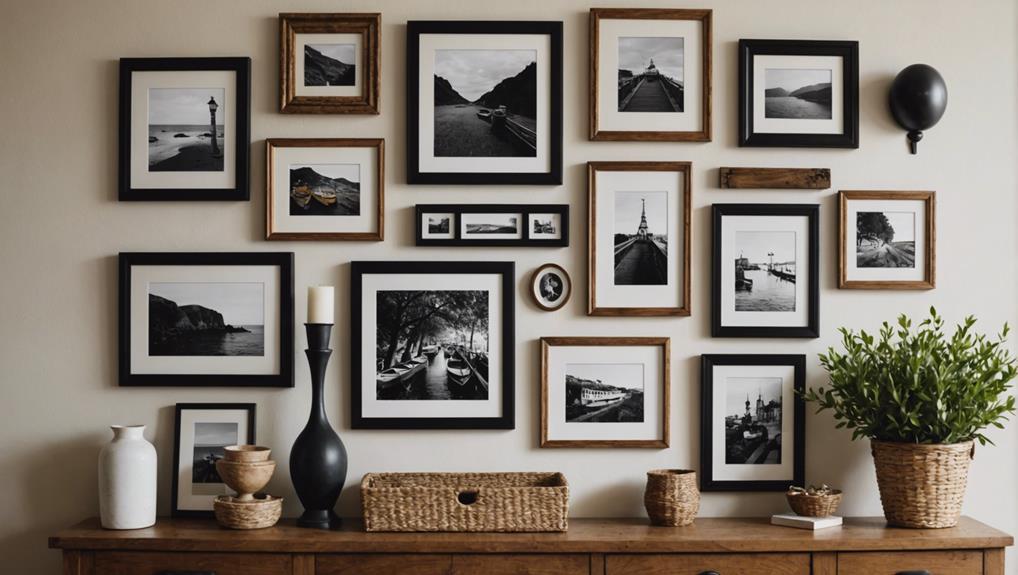
Home decor wall art encompasses various artistic pieces like paintings, prints, and sculptures to enhance your living space. It's meant to add personality, create focal points, and define the look of a room. Options range from nature-inspired to personalized pieces, offering a wide array of choices to suit different styles. Factors to take into account include aligning with existing decor, sizing, color harmony, and placement for best viewing. By choosing art that resonates with you and taking into account placement and mix of styles, you can create a cohesive look that reflects your taste. This brief overview captures the essence of home decor wall art.
Key Takeaways
- Diverse artistic pieces for visual appeal in home decor.
- Includes paintings, prints, sculptures for style and personality.
- Creates focal points, defines room look, and adds depth.
- Options range from nature-inspired to personalized pieces.
- Enhances living space with aesthetics, meaning, and mood impact.
Definition of Home Decor Wall Art
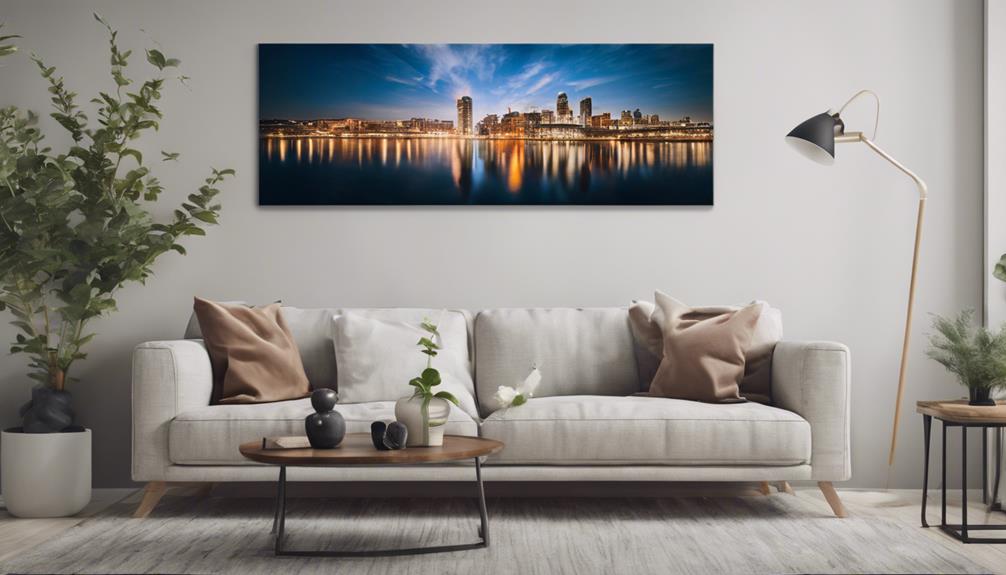
When delving into the world of home decor wall art, one finds a diverse array of artistic pieces aimed at enhancing the visual appeal of living spaces. Wall decor encompasses a wide range of art pieces, including paintings, prints, sculptures, and other creative works specifically designed for display on walls. The primary purpose of wall art is to add personality, style, and visual interest to a space, creating focal points and defining the overall look of a room.
Different styles of wall decor cater to various tastes and preferences, with options ranging from nature-inspired themes to cityscapes, abstract designs, and even personalized pieces. Choosing the right wall art can transform a room, making it feel complete while reflecting the homeowner's unique taste and personality. By carefully selecting and arranging wall decor, you can truly elevate the ambiance of your living space and make a statement that's both aesthetically pleasing and meaningful.
Types of Wall Art Decor
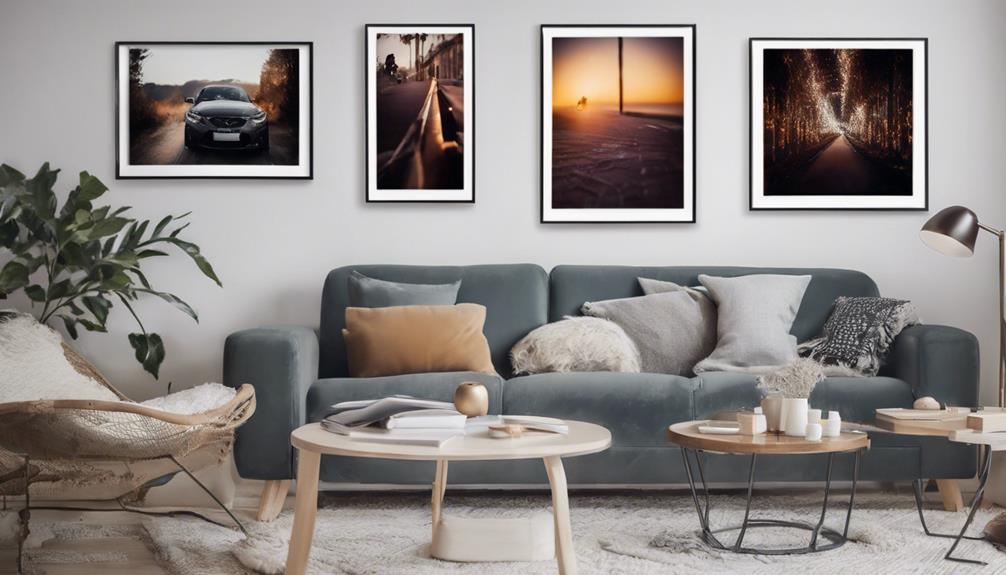
To explore the variety of wall art decor options, you can discover canvas paintings, framed prints, metal art, and tapestries among the diverse artistic pieces aimed at enhancing living spaces.
Metal wall art, in particular, offers a modern and industrial aesthetic to your home decor. These pieces are crafted from various metals like aluminum, copper, or steel, providing a sleek and contemporary look to your walls. Metal art can range from intricate designs to bold geometric shapes, adding depth and texture to your space.
The reflective properties of metal art can also help create the illusion of a larger room by bouncing light around the area. Whether you prefer abstract metal sculptures or intricately designed metal wall hangings, incorporating metal art into your home decor can be a striking way to make a statement and infuse your space with style.
Importance of Wall Art in Home Decor
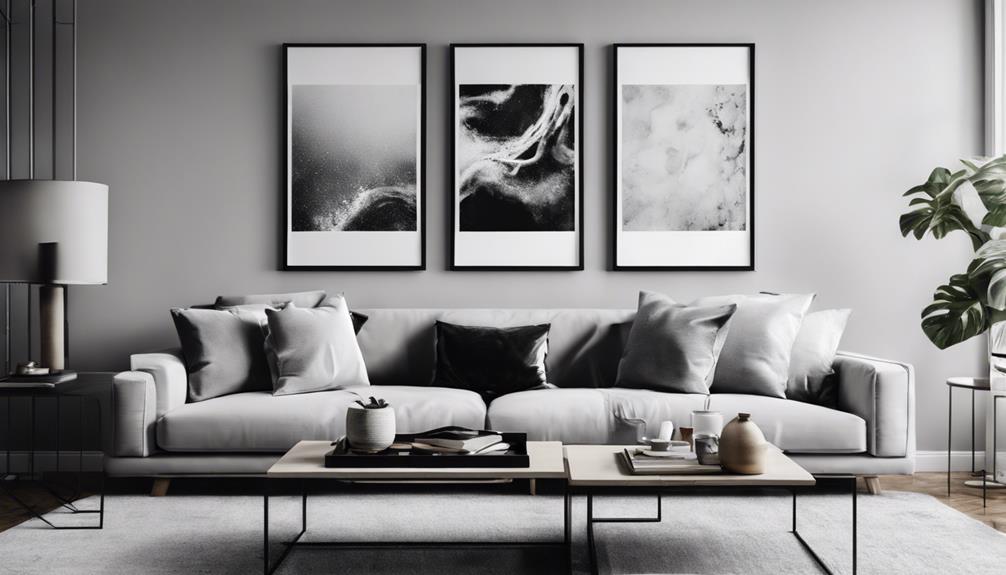
Enhancing your living space with wall art is essential for infusing style and personality into your home decor. Here's why wall art holds such importance:
- Visual Interest: Wall art transforms dull spaces into vibrant ones, reflecting your personal style and adding an aesthetic appeal that draws the eye.
- Focal Points: It creates focal points in a room, guiding the viewer's gaze and defining the overall aesthetics, enhancing the ambiance of the space.
- Psychological Benefits: Beyond aesthetics, wall art can reduce stress levels and create a sense of calm, impacting the mood and atmosphere of your home positively.
Factors to Consider When Choosing Wall Art

When selecting wall art for your home, it's crucial to take into account the style and theme to guarantee it aligns with your room's decor.
You should also pay attention to the size and placement of the artwork, ensuring it fits the space appropriately.
Additionally, think about the color and mood you want to evoke in the room with your chosen wall art.
Style and Theme
Consider aligning the style and theme of your wall art with your existing decor to achieve a cohesive and harmonious look in your space. When choosing wall art, take into account the following factors:
- Style of Existing Decor: Guarantee the wall art complements the overall aesthetic of your home decor, whether it's modern, traditional, or eclectic.
- Theme Selection: Opt for a theme that resonates with you, such as nature-inspired, cityscape, or abstract, to reflect your personality and create a cohesive feel in the room.
- Color Scheme: Harmonize the colors of the wall art with the room's palette to ensure it enhances the overall design and creates a visually pleasing environment.
Size and Placement
Select wall art sizes that are proportionate to your available wall space to guarantee a balanced and harmonious visual impact in your room. Consider the height of your ceiling when choosing the size of the wall art to maintain visual balance.
Place your wall art at eye level for best viewing and engagement with the artwork. Arrange multiple pieces of wall art in a gallery wall layout to create a cohesive and visually appealing display.
Maintain around 6-8 inches of distance between the wall art and furniture to establish a harmonious relationship between the elements in the room. By paying attention to the size and placement of your wall art, you can enhance the overall aesthetic of your space.
Color and Mood
Opt for wall art colors that align with your desired ambiance and mood to create a harmonious and emotionally engaging space. When selecting colors for your wall art decor, consider the following:
- Red: Ideal for adding energy and warmth to a room, making it a great choice for areas where you want to create a vibrant atmosphere.
- Blue: Known for its calming effect, perfect for spaces where relaxation is key, such as bedrooms or reading nooks.
- Yellow and Orange: These warm hues can infuse a sense of coziness and cheer, excellent for living rooms or dining areas where you want to promote sociability.
Tips for Styling Wall Art in Your Home
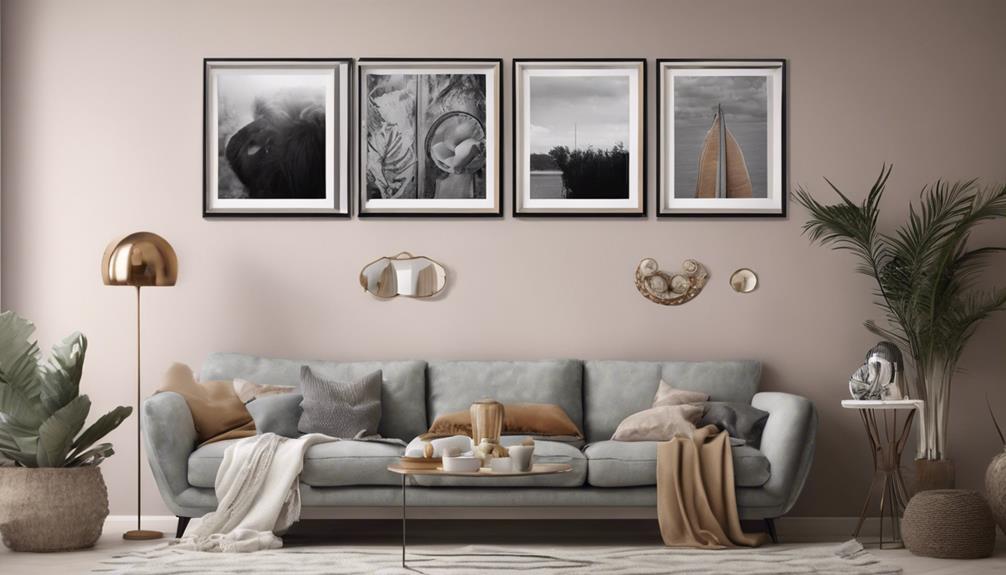
When styling wall art in your home, it's important to focus on choosing the right art pieces that resonate with you, considering factors like color, style, and theme.
Placement and arrangement play a vital role in creating a cohesive look, ensuring that the art complements the surrounding decor and doesn't overwhelm the space.
Mixing different styles and sizes of wall art can add visual interest, balance, and personality to your home while showcasing your individual taste and creativity.
Choosing the Right Art
To achieve a well-balanced and visually appealing home decor, consider the size and scale of wall art in relation to the surrounding space and furniture. When choosing the right art for your home, keep in mind the following:
- Complementing Decor Styles: Select art pieces that harmonize with the room's color scheme and overall decor style to enhance the aesthetic appeal.
- Mixing Art Mediums: Experiment with different art forms such as paintings, prints, and sculptures to add depth and visual interest to your space.
- Creating Focal Points: Use wall art to create focal points in the room, drawing attention and infusing personality into the decor.
Placement and Arrangement
Consider placing and arranging wall art in your home at eye level to guarantee visibility and aesthetic appeal. By following the rule of thirds, you can make a statement with multiple pieces by dividing the wall into three equal parts horizontally and vertically.
To create an engaging gallery wall, mix different sizes, shapes, and styles of art while leaving space between each piece to prevent overcrowding. Experiment with various layouts like grid, salon-style, or asymmetrical arrangements to find what suits your space best.
Each piece should stand out on its own, adding to the overall look and feel of the room. With these tips, you can showcase your unique style and personality through your wall art display.
Mixing Styles and Sizes
To create a visually engaging and personalized wall art display in your home, experiment with mixing different styles and sizes for a dynamic and eclectic look. Follow these tips to make it feel uniquely yours:
- Combine Various Styles: Mix modern, traditional, abstract, and other art styles for a diverse and interesting display.
- Play with Different Sizes: Layering different sizes of wall art adds depth and balance to your walls, creating a visually appealing arrangement.
- Showcase Your Personality: By combining various art pieces, you can make it feel like a true reflection of your personality and design aesthetic. Experiment with diverse styles and sizes to curate a gallery wall that speaks to who you are.
DIY Wall Art Ideas for Home Decor
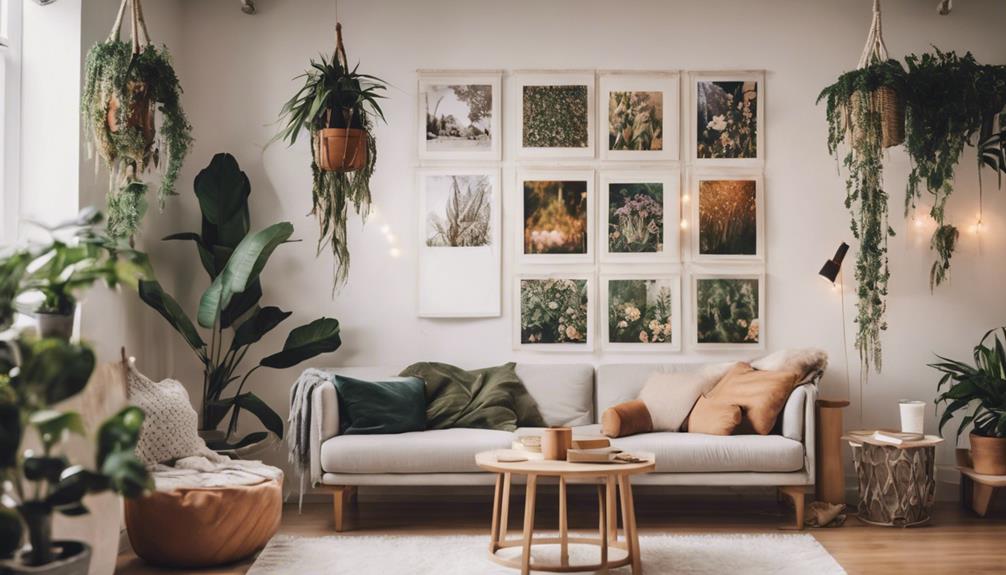
Crafting your own unique wall art pieces can elevate the aesthetic appeal of your living space while allowing you to showcase your creativity and style. DIY wall art ideas for home decor offer a personalized touch to your living room. Utilizing materials like canvas, paints, wood, and fabric, you can create custom pieces that reflect your personality.
Techniques such as stenciling, hand-painting, collage, and decoupage can bring texture and visual interest to your walls. Popular trends include upcycling old frames, incorporating geometric patterns, and using nature-inspired themes. These projects are cost-effective, environmentally friendly, and provide a creative outlet for expressing your artistic flair in your home decor.
Whether you're looking to add a pop of color, a touch of nature, or a unique focal point, DIY wall art allows you to tailor your living space to suit your tastes and preferences.
Popular Wall Art Trends
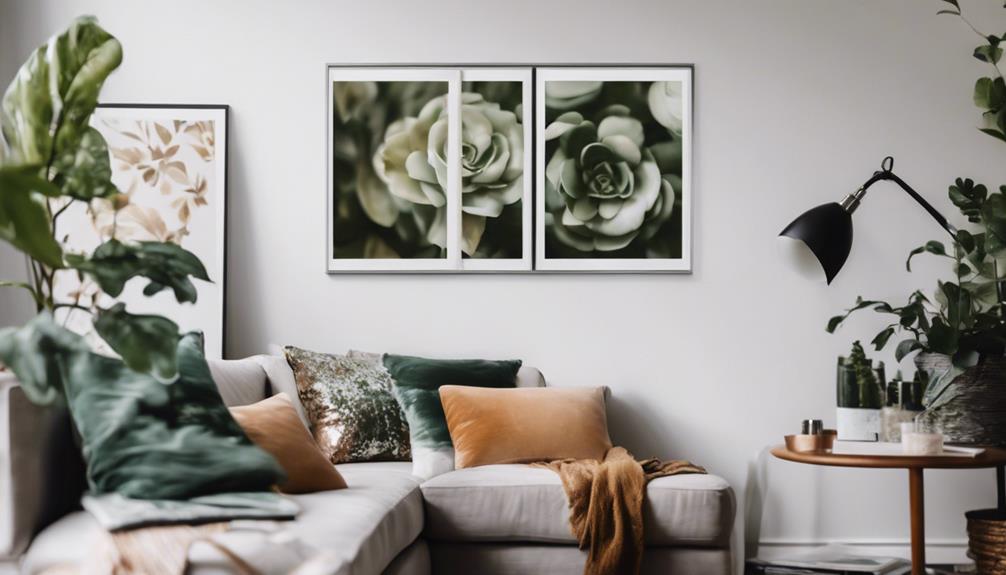
When exploring popular wall art trends, you'll find a wide range of nature-inspired pieces and cityscape art that are favored for modern decor. Here are some benefits of wall art to take into account:
- Nature-Inspired Pieces: Pieces like Eucalypt cascade and Whitehaven Beach paradise bring the calming essence of nature into your home, fostering a sense of tranquility and connection to the outdoors.
- Cityscape Art: Cityscape artworks such as Dusk falls in Paris and Amsterdam in mind capture the vibrancy and energy of urban life, adding a sophisticated and cosmopolitan touch to your space.
- Customization Options: With customization options for resin sculptures, you can create unique designs tailored to your personal preferences, ensuring that your wall art reflects your individual style and taste.
Incorporating wall art into your home decor not only serves as a focal point but also adds texture, dimension, and a personal touch that showcases your personality.
Where to Buy Home Decor Wall Art

Exploring various online retailers, physical stores, art galleries, and local artists provides diverse options for purchasing home decor wall art. Online giants like Amazon, Wayfair, and Etsy offer a wide range of wall art pieces suitable for any style or budget.
If you prefer a hands-on shopping experience, stores like HomeGoods, Target, and IKEA have a variety of wall art options to browse through in person. For those looking for unique and original pieces, art galleries and local artists are excellent places to find one-of-a-kind artworks that support local creativity.
If you desire a personalized touch, consider commissioning customized home decor wall art from artists or specialized online platforms. Subscription services such as Minted or Art.com provide curated collections of wall art for convenient and easy shopping experiences.
To explore more options or get in touch with specific vendors, don't hesitate to contact us for further assistance.
Frequently Asked Questions
What Is Home Decor Art?
Home decor art refers to decorative pieces that enhance the aesthetics of a room. It includes various artworks like paintings, prints, and sculptures. These pieces can be a focal point, adding style and interest to a space.
Different styles cater to various design preferences. Wall art transforms empty walls, creating personalized and visually appealing areas within a home. It plays a significant role in enhancing the overall ambiance of a room.
Is Wall Art Considered Home Decor?
Yes, wall art is considered home decor. It plays a crucial role in enhancing the aesthetics of a room, adding personality, and creating a focal point.
What Is the Purpose of Wall Decor?
Wall decor serves to transform dull spaces into vibrant ones by adding visual interest and reflecting personal style. It creates focal points in a room, defining aesthetics and enhancing the overall ambiance.
Wall art has psychological benefits, such as reducing stress and influencing feelings of calm and joy. It fills empty wall space, completes a room, and adds depth and dimension to the space.
Personalizing space with wall art helps tell a story, showcase personality, and express individual preferences and tastes.
What Is Wall Decor Called?
Wall decor is often called wall art. It includes a variety of artistic pieces like paintings, prints, and sculptures meant to beautify your walls. These pieces can transform a room, adding visual interest and reflecting your personal style.
Just like a painter uses a canvas to create a masterpiece, wall decor can be the artistic touch that completes the design look of your space. Its impact on ambiance and aesthetics is significant.
Conclusion
To sum up, home decor wall art serves as a symbol of personal style and creativity, adding a touch of sophistication to any living space.
By understanding the different types of wall art decor, considering key factors when choosing pieces, and following styling tips, you can enhance the aesthetic appeal of your home.
Whether you opt for popular trends or explore DIY ideas, wall art is a versatile and impactful element in home decor.
Home Decor
Timeless Navy Blue Shiplap Walls: Why Choose This Classic Design?
Achieve a sophisticated ambiance in any room with navy blue shiplap walls, a timeless design that elevates style and adds dramatic flair.
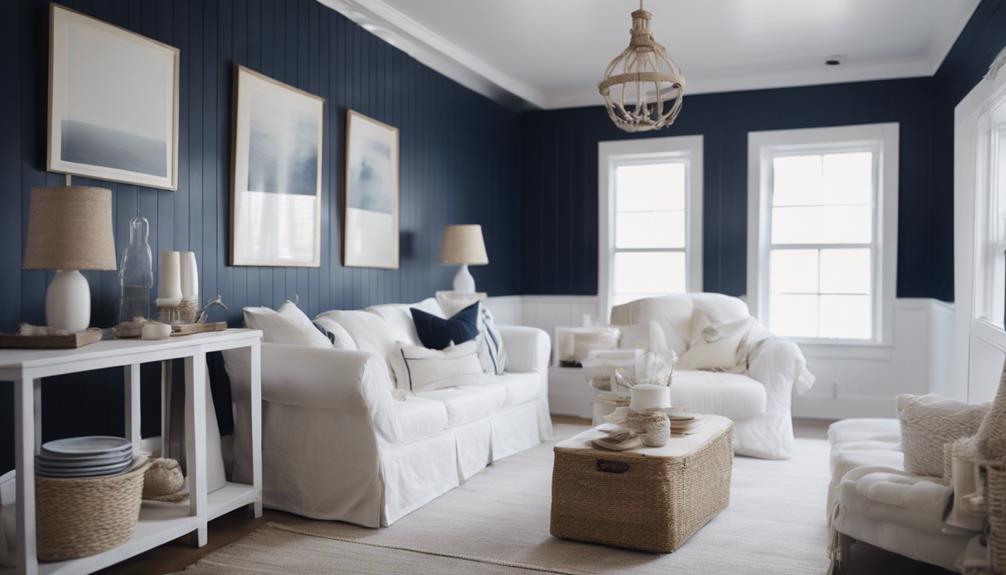
You're drawn to the timeless allure of navy blue shiplap walls because they evoke the luxurious ambiance of high-end hotels, upscale restaurants, and fashion brands, offering a versatile and sophisticated way to elevate the aesthetic of any room. This classic design choice provides a striking accent wall, enhances productivity in home offices, and adds personality to small kitchen spaces. Navy blue shiplap walls maintain their popularity due to their versatility and dramatic flair, making them a stylish choice for any space. As you explore this timeless design, you'll discover the countless ways it can transform your home's ambiance and character.
Key Takeaways
• Navy blue shiplap walls offer a timeless appeal that endures through changing trends and design styles.
• The versatile navy blue color adds depth and sophistication to any space, making it a classic design choice.
• Navy blue shiplap walls create a striking accent wall that enhances productivity and professionalism in home offices and adds personality to small kitchen spaces.
• Pairing navy blue shiplap with metallic accents, neutral tones, or bold patterns creates a visually striking contrast and adds elegance to any room.
• The dramatic, rich hue of navy blue shiplap commands attention, instantly elevating a room's ambiance and making a bold statement with its striking color choice.
Navy Blue Shiplap Design Inspiration
When designing a sophisticated space, you can draw navy blue shiplap design inspiration from luxurious hotels, upscale restaurants, or even high-end fashion brands that often pair navy blue with metallic accents for a sleek, modern look. By incorporating navy blue shiplap accent walls, you can create an elegant ambiance in any room, perfect for making a statement.
Imagine walking into a room with a stunning navy blue accent wall that demands attention and sets the tone for a sophisticated atmosphere. This design inspiration can be applied to various spaces, including home offices, where it can enhance productivity and professionalism. Additionally, a navy blue accent wall can add visual interest to a small kitchen, defining the design and creating a sense of luxury.
Whether you're looking to create a modern, luxurious, or elegant space, navy blue shiplap accent walls are an excellent design choice.
Accent Wall Ideas to Try Now
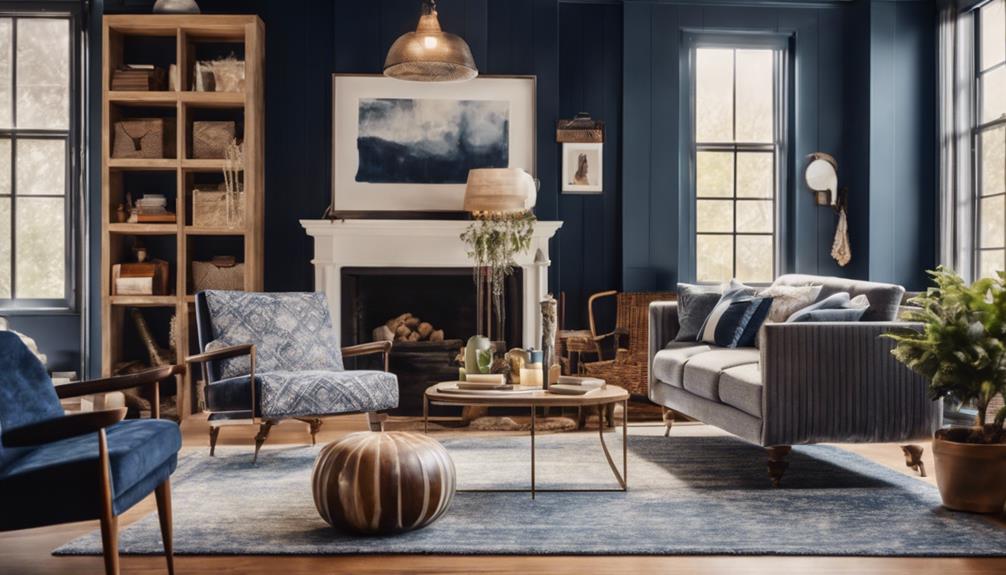
As you explore accent wall ideas to try now, you'll discover a range of styles that can elevate your navy blue shiplap walls.
From embracing coastal chic vibes only to experimenting with bold pattern play, you can create a unique look that reflects your personality.
Coastal Chic Vibes Only
To evoke the essence of a seaside retreat, incorporate navy blue shiplap accent walls into your design, and get ready to transport your space to a tranquil coastal oasis. The deep, calming blue tones of navy shiplap bring a sense of tranquility and elegance to any space, especially in coastal-themed designs. By incorporating navy blue shiplap accent walls, you'll create a sophisticated and calming atmosphere that's perfect for relaxing and unwinding.
Here are some ways to make the most of navy blue shiplap accent walls:
- Pair with natural elements: Combine navy blue shiplap with natural elements like driftwood-inspired decor to create a cohesive coastal look.
- Use as a focal point: Consider using navy blue shiplap on a focal wall to showcase artwork or create a stylish backdrop for furniture.
- Add a pop of contrast: Paint navy blue shiplap in a rich, bold hue like Hale Navy HC-154 to create a dramatic statement in your space.
Bold Pattern Play
Try pairing navy blue shiplap accent walls with bold pattern play to create a visually striking contrast that adds texture and visual interest to your space.
By incorporating bold patterns, such as geometric shapes, florals, or stripes, you can create a dynamic and eclectic look that's sure to turn heads. The key is to balance the boldness of the pattern with the richness of the navy blue shiplap walls, which add a touch of elegance and luxury to your home decor.
To achieve this balance, consider pairing bold patterns with neutral elements, such as white or beige furniture, to prevent visual overload. Alternatively, you can use the navy blue shiplap walls as a backdrop for a bold, patterned rug or statement furniture piece. The result is a visually striking space that's full of contrast and visual interest.
With navy blue shiplap walls as your foundation, the possibilities for bold pattern play are endless, and the outcome is sure to be a space that's both stylish and sophisticated.
Soft Neutral Pairings
Now that you've chosen navy blue shiplap walls, it's time to select a complementary color scheme that won't compete with their richness, and soft neutral pairings are an excellent way to achieve a harmonious balance. Soft neutrals can create a calming atmosphere, and when paired with navy blue shiplap, they bring a sense of serenity to the space.
Here are three soft neutral pairings to explore:
- Creamy Whites: Paint colors like Benjamin Moore's Swiss Coffee or Sherwin-Williams' Snowbound provide a balanced contrast to navy blue shiplap, creating a soothing ambiance.
- Subtle Blues: Farrow & Ball's Green Blue or Sherwin-Williams' Portsmouth can create a calming atmosphere when paired with navy blue shiplap, perfect for a relaxing retreat.
- Classic Whites: Benjamin Moore's White Dove or Sherwin-Williams' Alabaster offer a timeless and elegant pairing with navy blue shiplap, ideal for a sophisticated look.
When selecting a wall paint, remember that soft neutrals can enhance the classic appeal of navy blue shiplap walls. By choosing the right paint colors, you can create a harmonious and calming space that exudes elegance and sophistication.
Benefits of Timeless Design Choices
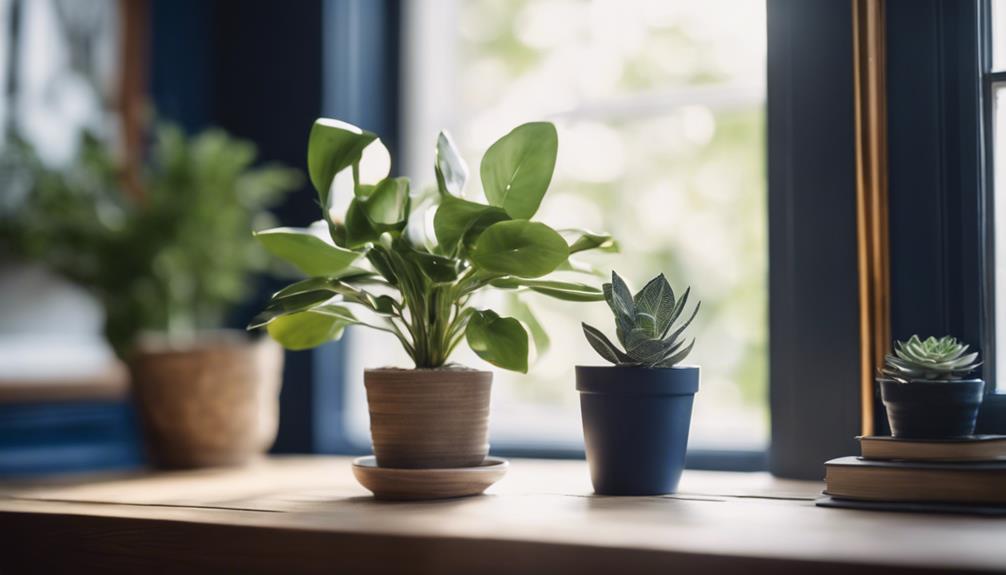
As you consider incorporating navy blue shiplap walls into your design, you'll appreciate the benefits of timeless design choices that exude classic style, which endures through the years.
With a navy blue shiplap wall, you'll create an elegant aesthetic appeal that adds sophistication to your space.
Classic Style Endures
By opting for navy blue shiplap walls, you're making a design choice that will guarantee the test of time, effortlessly outlasting fleeting trends and decor fads. This classic design choice guarantees that your space remains stylish and sophisticated, even as trends come and go. With navy blue shiplap walls, you can create a timeless ambiance that exudes elegance and refinement.
Here are three benefits of choosing navy blue shiplap walls:
- Timeless appeal: Navy blue shiplap walls offer a classic design choice that remains stylish and sophisticated, even as trends change.
- Versatility: The versatile navy blue color adds depth and sophistication to any space, making it perfect for various interior design styles.
- Elevated ambiance: Navy blue shiplap walls create a stylish and elegant ambiance, effortlessly elevating the overall aesthetic of your space.
Elegant Aesthetic Appeal
With navy blue shiplap walls, you'll create a sophisticated space that exudes calmness and tranquility, all while making a bold statement. The deep, rich hue of navy blue adds a level of sophistication to the room's overall design, making it perfect for those who want to create a stylish and calm atmosphere.
Unlike a bland, neutral paint color, navy blue shiplap walls make a statement without overwhelming the senses. This timeless design choice creates a classic and stylish backdrop for various decor styles, from traditional to modern.
Whether you're going for a coastal vibe or a sophisticated urban look, navy blue shiplap walls provide the perfect foundation. The versatility of this design choice allows it to work seamlessly in both traditional and modern settings, making it an excellent choice for anyone looking to add a touch of elegance to their space.
Lasting Visual Impact
You'll find that navy blue shiplap walls continue to captivate the senses long after the initial impression, thanks to their timeless design that makes a lasting visual impact. The classic navy blue color choice creates a striking focal point while maintaining a sense of elegance, adding sophistication and depth to any space. This enduring appeal lies in their ability to create a bold statement while remaining a classic and timeless design choice.
Here are just a few ways navy blue shiplap walls make a lasting visual impact:
- Sophistication and Elegance:
Navy blue shiplap walls add a touch of sophistication and elegance to any room, making it perfect for those who want to create a refined atmosphere.
- Versatility:
Choosing navy blue for shiplap walls provides a versatile backdrop that complements a wide range of decor styles and color schemes.
- Calmness and Serenity:
Navy blue shiplap walls can add a sense of calmness and serenity to a room, enhancing its overall ambiance.
Why Navy Blue Shiplap Stands Out

Navy blue shiplap's dramatic, rich hue commands attention, instantly elevating a room's ambiance and making a bold statement. You'll find that this classic design element stands out in any space, adding depth and sophistication to even the most mundane rooms.
One of the primary reasons navy blue shiplap stands out is its ability to create a striking accent wall, drawing the eye and creating a focal point in the room. This bold, yet timeless, design choice pairs perfectly with gold accents, resulting in a luxurious and elegant aesthetic.
In addition, incorporating navy blue shiplap in a home office can enhance productivity and create a stylish work environment. Even in small kitchen spaces, painting the back of lower cabinets with navy blue shiplap can add personality and visual interest.
With its versatility and dramatic flair, it's no wonder navy blue shiplap remains a popular design choice for those seeking to make a lasting impression.
Combining Shiplap With Other Styles
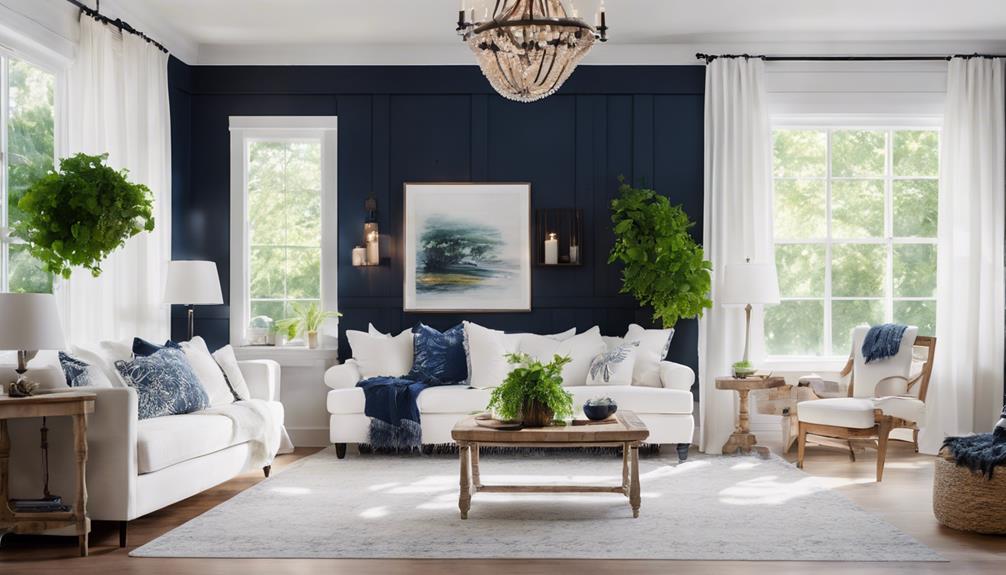
As you explore ways to incorporate navy blue shiplap into your design, consider blending it with other styles to create a unique, eclectic look that showcases your personal taste. By combining navy blue shiplap with other design elements, you can create a space that's truly one-of-a-kind.
Here are a few ways to combine navy blue shiplap with other styles:
- Traditional Twist: Pair navy blue shiplap with traditional elements, like ornate molding or vintage decor, for a classic and charming look.
- Coastal Cool: Mix navy blue shiplap with coastal design elements, like driftwood accents or nautical-themed decor, for a fresh and timeless aesthetic.
- Modern Contrast: Combine navy blue shiplap with modern decor, like sleek lighting fixtures or minimalist furniture, for a sleek and stylish contrast in any room.
When combining styles, don't be afraid to think outside the box. Consider adding a navy blue shiplap accent wall or ceiling to create a bold, eye-catching feature in your space. By blending different styles, you can create a look that's truly unique and reflective of your personal taste.
Elevating Traditional Spaces With Shiplap
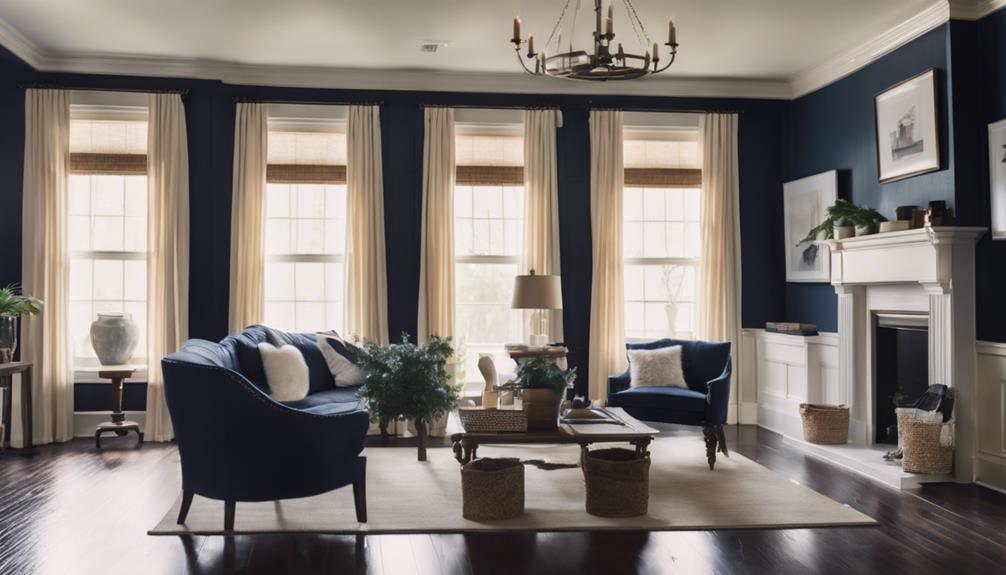
As you consider elevating traditional spaces with navy blue shiplap walls, you'll want to explore how this design element can bring together classic and modern elements.
Add textured interest to your rooms, and create sophisticated accent walls that make a statement.
By incorporating navy blue shiplap, you can achieve a unique blend of timeless elegance and modern flair.
Let's examine how these three key aspects can transform your traditional spaces into something truly remarkable.
Classic Meets Modern Twist
By incorporating navy blue shiplap walls into traditional spaces, you can create a striking visual contrast that seamlessly blends classic and modern elements. This timeless design choice adds sophistication and depth to any room, making it perfect for those who want to elevate their space without sacrificing style.
Here are three reasons why navy blue shiplap walls are a great choice for traditional spaces:
- Sophisticated Backdrop: Navy blue shiplap provides a bold yet elegant backdrop for various decor styles, allowing you to experiment with different design elements.
- Dramatic Flair: The deep navy blue hue adds a touch of drama and richness to the space, enhancing the overall aesthetic.
- Fresh Take on a Classic: The combination of navy blue with traditional shiplap design elements offers a fresh and stylish take on a classic look, perfect for those who want to add a modern twist to their space.
Adding Textured Interest
You can introduce textured interest to your traditional space by incorporating navy blue shiplap walls, which provide a unique visual element that enhances the room's character.
The closely arranged planks of shiplap walls add a tactile quality, creating a sense of depth and visual interest. Navy blue shiplap, in particular, offers a bold yet classic look that elevates traditional spaces.
The texture of these walls can enhance the character and charm of a room, making it feel cozy and inviting. By incorporating navy blue shiplap, you can transform a space, adding a timeless appeal that never goes out of style.
The navy blue hue adds a sense of sophistication, while the shiplap texture provides a rustic touch, creating a beautiful contrast that adds depth to the room. With navy blue shiplap walls, you can create a space that exudes warmth and character, perfect for relaxing and entertaining.
Sophisticated Accent Walls
Navy blue shiplap accent walls inject a dose of sophistication into traditional spaces, effortlessly elevating the room's style and charm. By incorporating this classic design element, you can transform a room into a stylish and inviting space. The deep navy hue creates a striking contrast against the classic white shiplap design, adding depth and character to any room.
Here are three ways navy blue shiplap accent walls can elevate your space:
- Elegant Backdrop: Navy blue shiplap walls provide a timeless and versatile backdrop for various decor styles, allowing you to mix and match furniture and accessories with ease.
- Sophisticated Contrast: The contrast between the navy blue and white shiplap creates a visually appealing combination that adds depth and visual interest to the room.
- Elevated Ambiance: The sophisticated ambiance created by navy blue shiplap accent walls can instantly elevate the mood and atmosphere of the room, making it perfect for relaxing or entertaining.
Shiplap Wall Installation and Care

To achieve a seamless look, fit the wooden planks tightly together, either horizontally or vertically, guaranteeing a polished finish with minimal gaps. This attention to detail will make your navy blue shiplap walls stand out.
When you install shiplap, you can choose to create a unique look by adding a shiplap ceiling to complement your walls. To install shiplap, start by preparing your surface, then measure and cut your planks to fit. Apply a level to ensure straight lines, and use a nail gun to secure the planks to the wall.
After installation, maintain your shiplap walls by regularly dusting or vacuuming to prevent dirt buildup. Occasionally, clean your walls with mild soap and water to keep them looking their best. For added protection, consider sealing or painting your shiplap walls to prevent moisture and stains.
Pairing Navy Blue With Neutral Tones
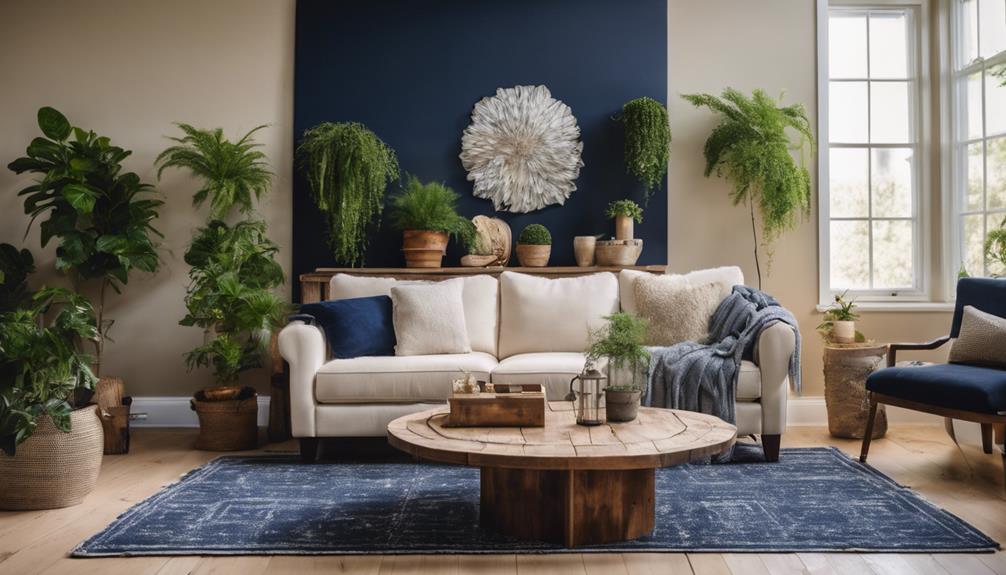
By incorporating neutral tones into your design, you can create a stunning visual harmony that showcases the sophistication of navy blue shiplap walls. The contrast between the deep blue hue and neutral tones creates a sophisticated and elegant feel in any space.
Here are three reasons why pairing navy blue with neutral tones is a winning combination:
- Balanced backdrop: Neutral tones provide a balanced backdrop for navy blue shiplap walls, allowing the deep blue hue to stand out as a focal point.
- Versatility in design: Navy blue and neutral color combinations offer versatility in design, blending seamlessly with various styles and decor elements.
- Visual interest: The combination of navy blue shiplap with neutral tones adds depth, dimension, and visual interest to a room while maintaining a sense of tranquility.
Creating a Focal Point With Shiplap
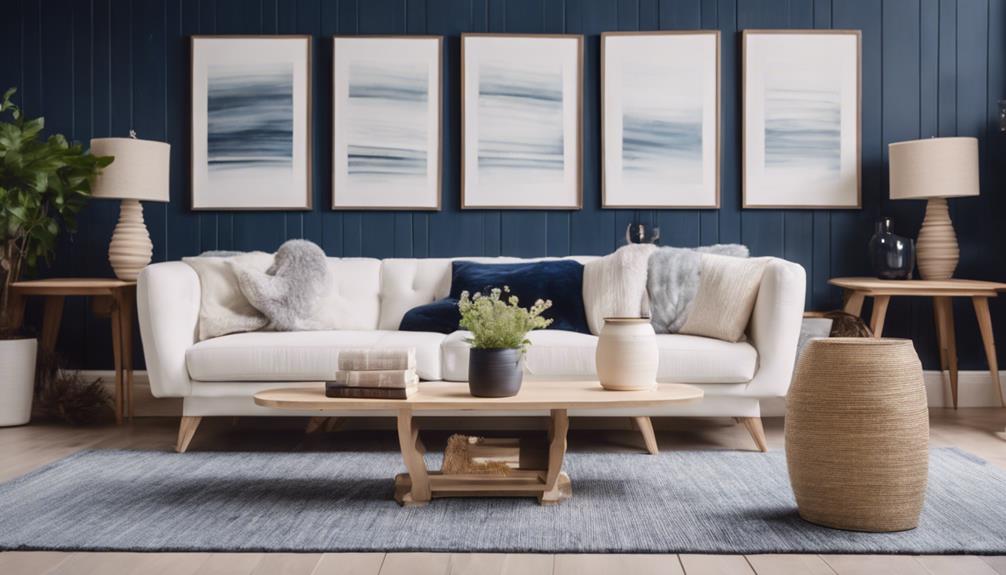
One striking way to create a focal point in your room is to incorporate navy blue shiplap walls, which instantly draw the eye and add depth to the space.
By using shiplap, you're creating a visual anchor that guides the viewer's attention to a specific area of the room. The navy blue color adds a level of sophistication and elegance, making the space feel more luxurious.
You can also use shiplap to accentuate architectural features, such as a statement wall or a fireplace surround, drawing attention to the room's unique characteristics. Additionally, shiplap can be used to highlight built-in shelving or other design elements, adding character to the room.
Timeless Design for Any Home Style
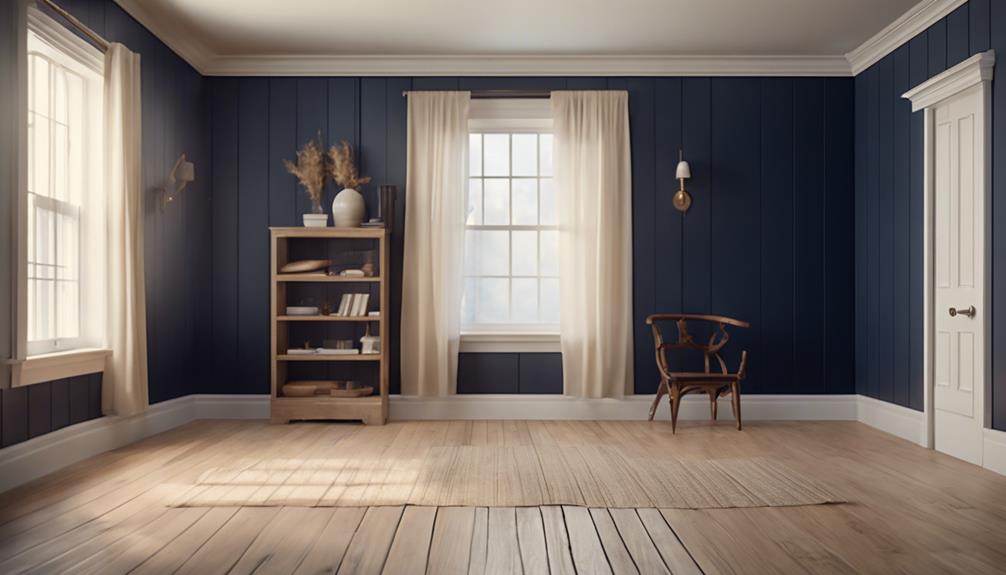
Navy blue shiplap walls effortlessly bring a touch of sophistication to any home style, seamlessly blending with diverse decor elements to create a unique and enchanting space. You can rest assured that this classic design choice will complement your home's aesthetic, regardless of its style. Whether you have a modern, traditional, or eclectic home, navy blue shiplap walls will add a touch of elegance and refinement.
Here are just a few reasons why navy blue shiplap walls are a timeless design choice for any home style:
- Universal appeal: Navy blue shiplap walls complement a wide range of decor styles, from modern to traditional, and everything in between.
- Classic look: The navy blue color adds depth and richness to spaces, providing a stylish and elegant atmosphere that never goes out of style.
- Versatility: Navy blue shiplap walls can serve as a backdrop for artwork, furniture, or other decorative elements in the space, making them a versatile design choice.
Frequently Asked Questions
What Is the Most Timeless Wall Color?
When deciding on the most timeless wall color, you're likely considering options that won't go out of style anytime soon. You've probably narrowed it down to a few neutral shades, but what about a bolder choice?
While whites and creams are classic, a rich, dark hue like navy blue can add sophistication and depth to a room. In fact, navy blue is a versatile color that can blend seamlessly with various design styles and palettes, making it a timeless choice for your walls.
Is Shiplap a Timeless Look?
You might think shiplap is just a fleeting trend, but you'd be surprised to learn that it's actually a timeless look.
Considered a classic design element, shiplap has been popular for centuries, offering a clean, inviting aesthetic that adds warmth and character to any space.
Its versatility and ability to hide imperfections make it a durable and enduring choice, perfect for various home styles and designs.
What Color Is Traditional Shiplap?
You might think traditional shiplap is always white, but that's not the case. While white is a classic choice, traditional shiplap can actually be painted in various colors.
Soft white hues like Cloud White 967 or Swiss Coffee OC-45 are popular options, but you can also opt for darker shades like Hale Navy HC-154 or subtle blues like Mineral Springs CC-848, offering a range of design possibilities.
What Is the Best Color for Shiplap Walls?
As you ponder the perfect hue for your shiplap walls, consider this: the best color is one that harmonizes with your personal style and complements the space's ambiance.
Like a masterful painter, you're searching for the ideal shade to bring your vision to life. While neutrals like white or gray are popular, don't be afraid to think outside the box – or in this case, the shiplap.
Conclusion
To sum up, you've seen how timeless navy blue shiplap walls can elevate your home's style.
Did you know that according to a National Association of Home Builders survey, 60% of homeowners prefer a classic, traditional design style, making navy blue shiplap a great fit?
By incorporating this design element, you'll not only create a stunning visual effect but also tap into a timeless aesthetic that will remain beautiful for years to come.
Vivienne – Your Content Companion Vivienne is your content companion, curating valuable tips, advice, and inspiration to guide you on your home decor journey. From insightful blog posts to informative product descriptions, she’s here to empower you with the knowledge you need to create your dream space.
Interior
How Long Should an Interior Detail Take
A detailed look at factors influencing interior detailing time, from vehicle size to special services, will answer your burning question.

When it comes to interior detailing, the time it takes can vary depending on different factors. Factors like the size of your vehicle, how intricate the interior design is, and if you need extra services such as pet hair removal all play a role. On average, interior detailing sessions typically last between 2 to 6 hours. Larger vehicles usually take longer, while compact cars might need just 3 to 4 hours. If you want to know more about how these factors affect detailing time, keep exploring to learn valuable insights that can help you understand the process better.
Key Takeaways
- Average interior detailing time ranges from 2 to 6 hours.
- Vehicle size, complexity, and condition influence detailing duration.
- Experienced detailers complete sessions in 2 to 4 hours.
- Add-ons like coatings or odor treatments extend detailing time.
- Quality products enhance results and shorten detailing duration.
Factors Affecting Detailing Duration
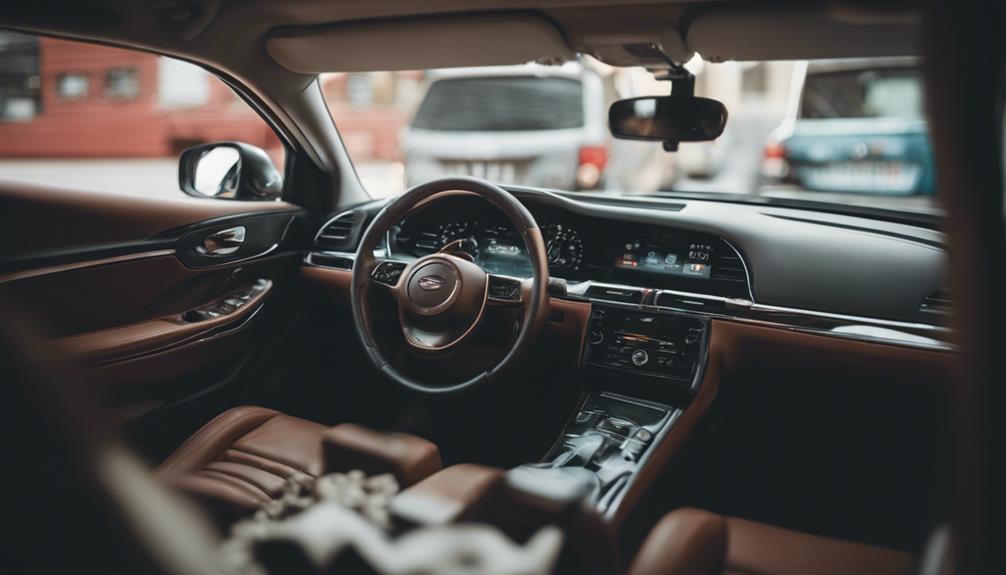
When determining the duration of an interior detail, various factors come into play. The size of the vehicle is one important aspect to take into account. Larger vehicles naturally require more time to clean thoroughly compared to smaller ones.
Additionally, the complexity of the interior, such as intricate designs or hard-to-reach areas, may demand extra attention and time during the detailing process. Suppose you opt for additional cleaning services like pet hair removal. In that case, this will also increase the overall detailing time for the interior.
Furthermore, the experience level of the detailer is another significant factor influencing how long the interior detail will take. A more experienced detailer is likely to work more efficiently and effectively, potentially reducing the time needed for the detailing session.
Keep in mind that on average, interior detailing sessions typically range from 2 to 6 hours, depending on these and other factors.
Average Time for Car Sizes

For different car sizes, the average time needed for a full interior detail varies depending on the size and condition of the vehicle. When it comes to interior detailing, the time it takes can vary greatly based on the size and type of vehicles.
Here is a breakdown of the average time required for different car sizes:
- Standard cars typically require 4 to 5 hours for a thorough interior detail.
- Larger vehicles like big SUVs may take 5 to 6 hours for thorough cleaning.
- Compact cars often need around 3 to 4 hours to complete a full interior detail.
- Luxury vehicles with intricate interiors might demand 6 to 7 hours for a meticulous detailing session.
Interior Detailing Components

If you're looking to tackle the nitty-gritty of car cleanliness, understanding the key interior detailing components is essential. Interior detailing involves a variety of tasks to make sure your car's interior is impeccable. This includes vacuuming to remove dirt and debris, wiping surfaces clean, cleaning upholstery for a fresh look, conditioning leather to maintain its quality, and making sure windows are crystal clear. In addition, tasks like steaming, using extractors for deep cleaning, and applying protectant for long-lasting shine are common in interior detailing processes.
Attention to detail is vital, especially in hard-to-reach areas like cracks and crevices where dirt tends to hide. Taking the time to meticulously clean these areas will result in a thorough interior detail. On average, a standard car interior detail can take around 4-5 hours, while larger SUVs may require 5-6 hours due to their size. Remember, giving proper attention to detail and not rushing through the process will ensure a high-quality interior detail job.
Time Estimates for Add-Ons
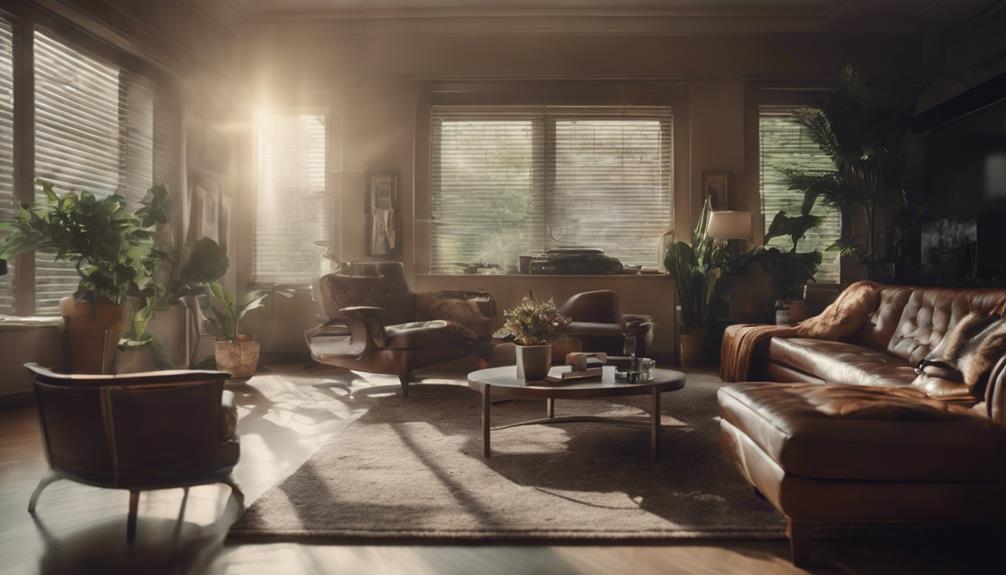
When opting for add-ons like leather or fabric coatings during interior detailing, you're looking at an extra hour of detailing time.
Odor treatment add-ons also tack on another hour to the process.
These additional services not only enhance protection and aesthetics but also contribute to a more thorough cleaning process, increasing the total time required for your interior detailing session.
Additional Service Durations
When adding extra services like leather coating, fabric coating, or odor treatment to your interior detailing appointment, expect an additional hour to be included in the overall service duration. These add-ons enhance protection and aesthetics for your vehicle, but they also contribute to the total time needed for interior detailing services.
Here are some estimated durations for common add-ons:
- Leather coating add-on typically takes an extra hour to complete.
- Fabric coating add-on can extend the duration of interior detailing by one hour.
- Odor treatment add-on usually requires about an hour for completion.
Various add-ons like leather conditioning, fabric coating, and odor treatment play a role in increasing the overall time required for interior detailing services.
Impact on Total Time
Adding extra services such as leather coating, fabric coating, or odor treatment to your interior detailing appointment will impact the total time required for the service, with each add-on typically adding an extra hour to the overall duration.
While these add-ons offer enhanced protection and aesthetic benefits, they also extend the duration of your interior detail session. Leather coating can elevate the luxurious feel of your car but requires additional time for application.
Opting for fabric coating adds another layer of defense against stains and spills, albeit prolonging the detailing process.
Lastly, odor treatment, while important for a fresh-smelling interior, contributes an extra hour to the total time needed for a detailed interior detail.
Consider these factors when choosing add-on services to tailor your interior detail experience.
Influence of Vehicle Condition

The vehicle's condition greatly influences the time required for completing an interior detail. When considering the interior of a vehicle, its state can markedly impact the time needed for a thorough cleaning. Here are some key points to understand how the vehicle's condition affects the detailing process:
- Dirtier Interiors: Vehicles with excessive dirt and grime will require more time for cleaning and restoration.
- Stains and Odors: Dealing with stubborn stains, odors, and built-up grime can prolong the detailing process.
- Well-Maintained Vehicles: Cars that are regularly cleaned and maintained will generally take less time to complete the interior detail.
- Pre-existing Damage: If the interior components have existing damage or neglect, extra time may be necessary to achieve the desired results.
Considerations for Time Management
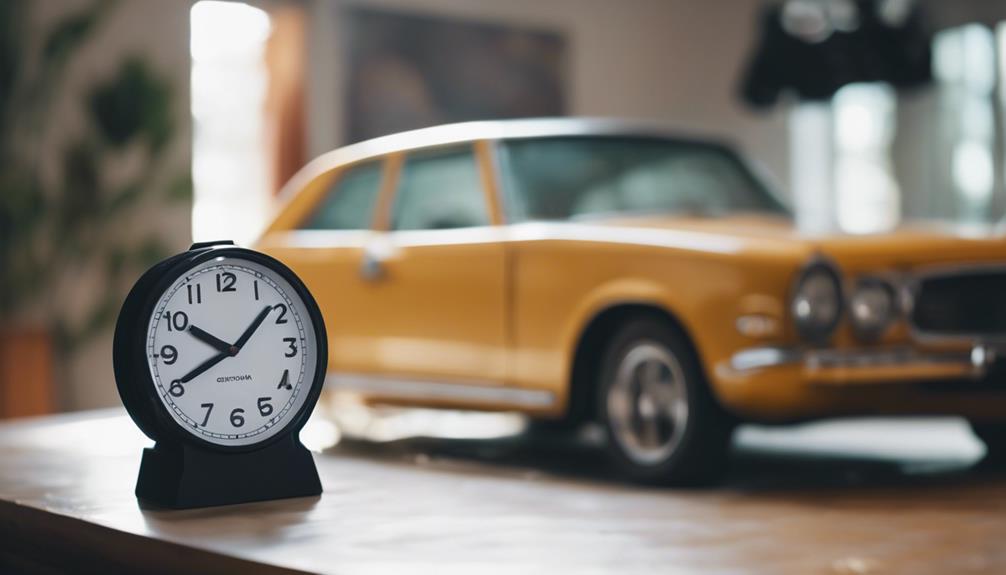
When approaching interior detailing, it's crucial to incorporate time management techniques that can help streamline your workflow. By utilizing efficient strategies and prioritizing tasks effectively, you can optimize the time spent on each job.
Time-Saving Techniques
To save time during interior detailing, focus on prioritizing tasks that have the most impact on the overall cleanliness of the vehicle. Implement these time-saving techniques:
- Spot Cleaning: Address visible dirt and stains first.
- Multi-Tasking: Work on multiple areas simultaneously.
- Use Efficient Tools: Opt for tools that speed up the cleaning process.
- Regular Maintenance: Keep up with routine cleaning to prevent heavy buildup.
Efficient Workflow Strategies
Considering the time-saving techniques mentioned earlier, streamlining your interior detailing process through efficient workflow strategies can further enhance your productivity and overall results.
When tackling interior detailing, optimizing your workflow based on the vehicle size is key. For smaller cars, focus on maximizing efficiency by starting with vacuuming, then progressing to wiping surfaces and cleaning windows.
Larger vehicles require a more structured approach, ensuring each area receives adequate attention to detail. Prioritize tasks based on the size and layout of the vehicle to work systematically and avoid unnecessary backtracking.
Prioritizing Tasks Effectively
To effectively prioritize tasks in interior detailing, focus on organizing your workflow to maximize time efficiency and guarantee thorough cleaning. Here are some key considerations for time management:
- Start by evaluating the vehicle's condition to determine the areas that require the most attention.
- Prioritize tasks such as vacuuming, wiping surfaces, steaming, using extractors, applying protectant, and cleaning windows based on their importance.
- Ensure you allocate sufficient time to clean all areas, including cracks and crevices, to deliver a high-quality service.
- Keep in mind to balance your time spent on cleaning with customer satisfaction to ensure a successful interior detailing service.
Duration Based on Detailer Experience

Experienced detailers typically complete an interior detail in about 2 to 4 hours. Their proficiency comes from years of practice, allowing them to efficiently tackle each task with precision.
Novice detailers, on the other hand, may take longer, averaging around 4 to 6 hours for the same job as they're still learning the ropes. As one gains experience in the art of detailing, the time spent on each interior detail decreases considerably.
Professional detailers with extensive experience can achieve even faster and high-quality results, often finishing the job in record time while maintaining exceptional standards.
Hiring an experienced detailer ensures not only a quicker turnaround but also a more thorough interior detailing session, leaving your vehicle looking spotless and refreshed in no time.
Recommended Interior Detailing Products
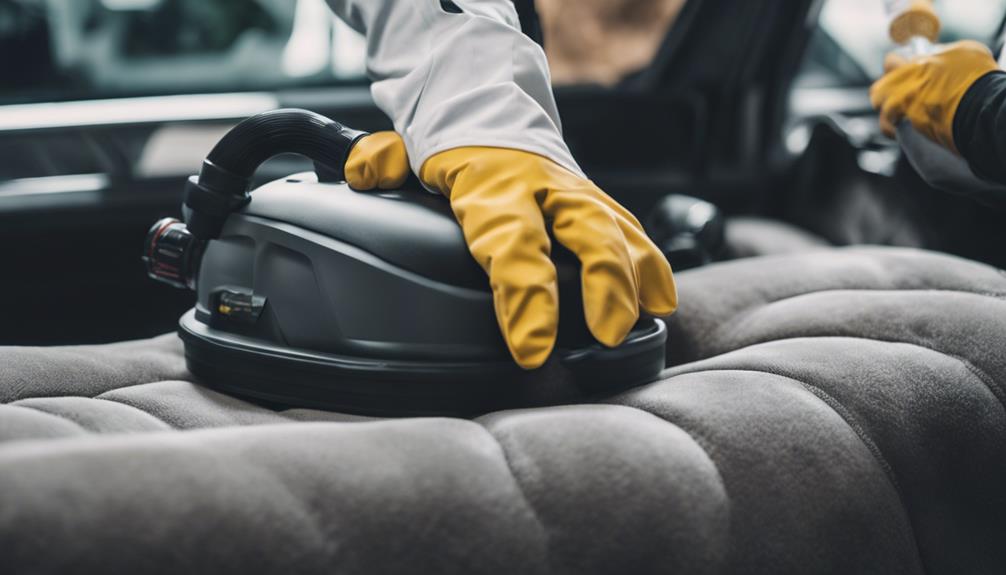
For best cleaning results and enhanced interior appearance, investing in high-quality interior detailing products is essential. When it comes to maintaining your vehicle's interior, using the right products can make a significant difference. Here are some recommended interior detailing products to help you keep your car looking its best:
- HydroSilex Recharge Interior Ceramic Coating Spray: This product offers effective protection for all interior materials, ensuring they stay clean and well-maintained.
- HydroSilex Plastic & Leather Interior Cleaner: Specifically designed to clean plastic, vinyl, and leather surfaces, this cleaner efficiently removes dirt and grime without damaging the materials.
- Selecting high-quality interior detailing products: Opting for premium products guarantees excellent cleaning results, preserving the appearance and longevity of your interior surfaces.
- Using specialized interior cleaners: These products help enhance the overall look and feel of your vehicle, making it a more pleasant space to be in.
Investing in high-quality interior detailing products is a worthwhile choice that can elevate your driving experience and protect your vehicle's interior.
Sign Up for Exclusive Offers
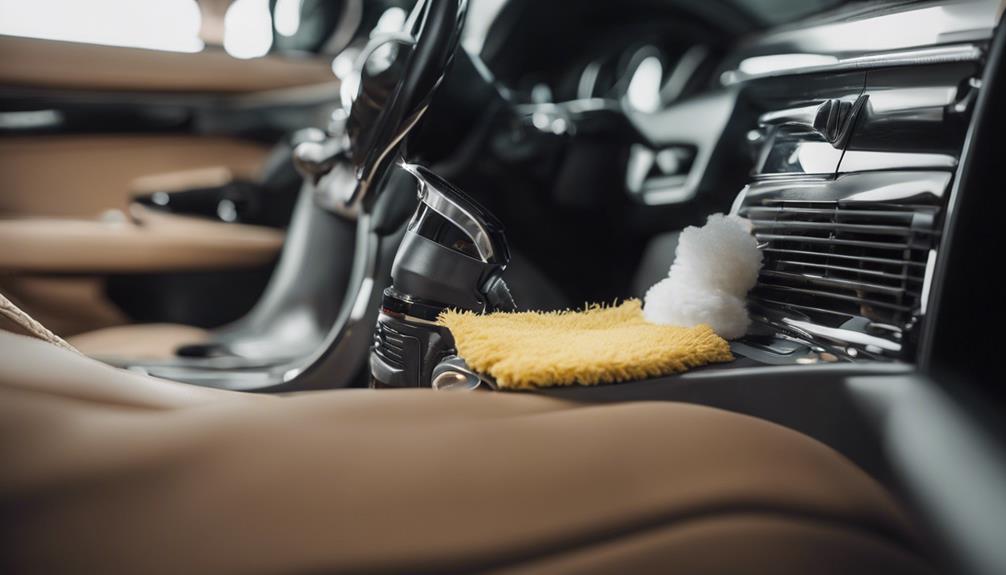
Considering the benefits of exclusive offers, joining a detailing service's newsletter can reveal valuable discounts and promotions for your interior detailing needs.
When you sign up for exclusive offers, you gain access to a range of deals tailored specifically for interior car details. These offers may include discounts on services, special package deals, or promotions that can help you save on your detailing expenses.
By subscribing to a detailing service's newsletter, you not only stay informed about cost-saving opportunities but also get updates on new services and products available. Exclusive offers are designed to attract and retain customers, so taking advantage of these deals can provide you with added benefits as a regular customer.
Whether it's a limited-time discount or an incentive to try out new services, signing up for exclusive offers from detailing services can enhance your interior detailing experience and help you save money in the process.
Don't miss out on these exclusive opportunities – sign up today!
Frequently Asked Questions
How Long Should It Take to Detail the Inside of a Car?
When detailing the inside of your car, the time it takes depends on the vehicle's size and condition. A standard car may need about 4 to 5 hours for a thorough interior cleaning, while larger SUVs could take 5 to 6 hours.
To speed up the process, focus on all areas, including nooks and crannies, and prioritize tasks efficiently. Balancing cleaning time with customer satisfaction is key to achieving a like-new interior appearance.
How Long Should a Detail Last?
When considering how long a detail should last, focus on quality over speed. A detail should take as long as needed to guarantee every nook and cranny shines. Don't rush the process; attention to detail pays off in the end.
Why Does Detailing Take so Long?
Detailing takes time due to the thoroughness required. Vacuuming, wiping, and treating every nook and cranny ensure a spotless interior.
Various tools like extractors and steamers are used for deep cleaning. By focusing on each task diligently, the end result is a pristine interior that meets high standards.
Taking your time guarantees a high-quality finish that will impress even the most discerning customers.
Is Interior Detailing Worth It?
Interior detailing is definitely worth it! It helps maintain your car's value, provides a fresh driving experience, and creates a healthier atmosphere.
Regular detailing prevents damage and extends your car's interior lifespan. For maximum benefits, consider detailing every 6 months or more for high-traffic vehicles.
Conclusion
To sum up, the average time for an interior detail can vary depending on factors such as car size, condition, and add-ons.
One interesting statistic is that experienced detailers can often complete a full interior detailing in as little as 1-2 hours, while beginners may take longer.
By using the right products and managing time effectively, you can guarantee a thorough and efficient interior detail for your vehicle. Remember, practice makes perfect!
Home Decor
What Does a Home Decor Assistant Do
Wondering how a Home Decor Assistant transforms spaces? Discover their role in creating stunning residential designs.
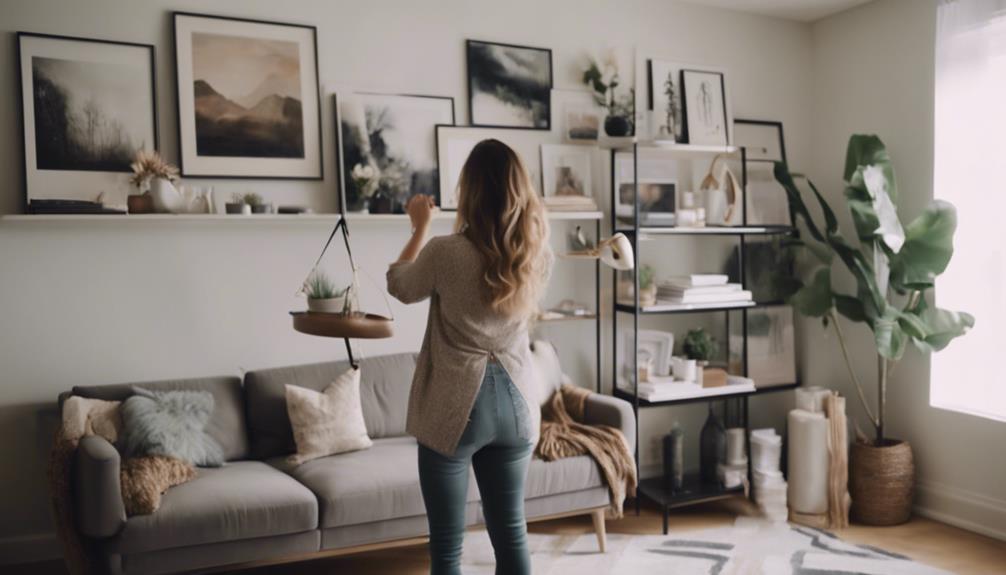
As home decor assistants, we help select, arrange, and bring creative design plans to life in residential spaces. Duties involve collaborating with designers, attending client meetings, and measuring rooms. We assist in purchasing decor products within set budgets and stay updated on current trends. In setting up spaces, we meticulously arrange furniture, coordinate with designers, and guarantee visual harmony. Administrative tasks include inventory maintenance, vendor coordination, and client communication. Our role contributes to project execution by managing timelines, creating design concepts, and collaborating with team members. Discover more about the diverse responsibilities of a home decor assistant.
Key Takeaways
- Assist in selecting furniture, accessories, and artwork for design projects.
- Collaborate with designers to implement creative design plans efficiently.
- Source and purchase home decor products within specified budgets.
- Help in setting up design spaces by arranging furniture and decor items meticulously.
- Support administrative duties like inventory management, client communication, and project coordination.
Responsibilities of a Home Decor Assistant
As Home Decor Assistants, we assist in selecting and arranging furniture, accessories, and artwork to enhance residential spaces. In Interior Design Assistant Jobs, we work closely with clients to understand their preferences and collaborate with designers to implement creative design plans.
Our responsibilities include attending meetings with clients and designers, taking photographs, and measuring rooms to guarantee accurate placements of home decor items. We actively participate in consultations to gather information on budget constraints and client needs. Additionally, we source and purchase home decor products within specified budgets, coordinating deliveries and installations in clients' homes.
Staying updated on the latest trends in home decor is essential to provide innovative and appealing design solutions. Our role involves a blend of creative duties and practical tasks, ensuring that every detail contributes to the overall aesthetic and functionality of the residential space.
Tasks Involved in Home Decor Assistance

In our role as Home Decor Assistants, we perform a variety of tasks to enhance residential spaces through furniture selection and decor coordination. Here are some key responsibilities we handle:
- Assist: We assist in selecting and coordinating furniture, accessories, and decor items for interior spaces, aligning with clients' design preferences.
- Design: Collaborate with clients to understand their design preferences and create mood boards or design schemes to capture the desired aesthetic.
- Source: We source and purchase home decor items within specified budgets and timelines, ensuring quality and style standards are met.
- Coordinate: Coordinate with vendors, contractors, and suppliers for the procurement and installation of home decor products, ensuring a seamless process.
- Stay Updated: Stay informed about current home decor trends, styles, and materials to provide innovative design solutions that resonate with modern interior design preferences.
Role in Setting Up Design Spaces
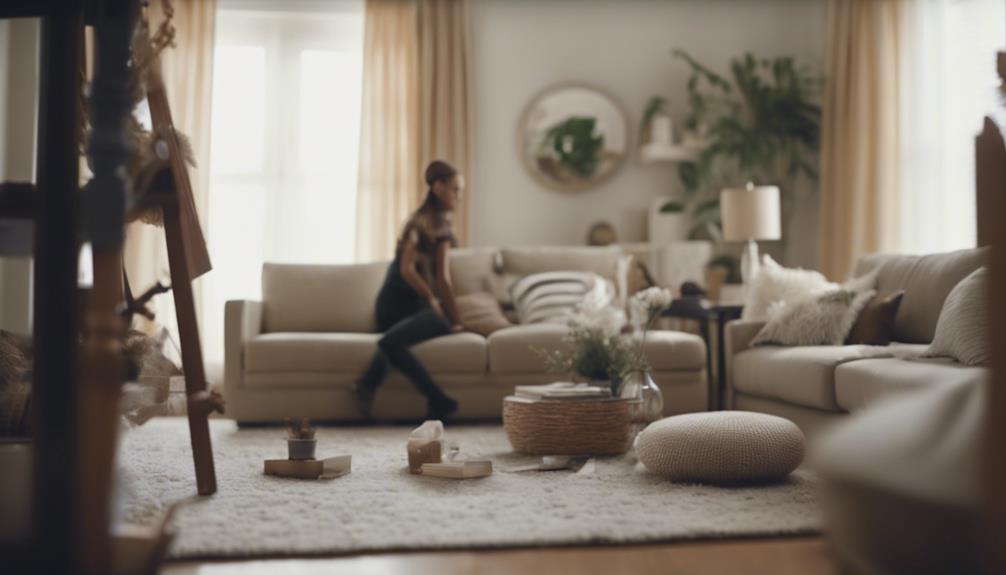
Playing a pivotal role in transforming design concepts into reality, home decor assistants meticulously arrange furniture, accessories, and decor items according to a designer's plan. They work closely with interior designers to guarantee client arrangements align with the visual aesthetic envisioned.
In addition to setting up furniture, home decor assistants may aid in hanging artwork, installing lighting fixtures, and positioning rugs to enhance the overall design scheme. Attention to detail is essential as they organize shelves, select color schemes, and ensure design elements complement each other harmoniously.
Creativity plays a significant role in their tasks, as they must bring the designer's vision to life while considering the client's preferences. Home decor assistants play an important role in creating cohesive and visually appealing environments, making them essential in the world of interior design assistant jobs.
Their ability to execute the designer's plan with precision and creative flair sets the stage for stunning design spaces.
Administrative Duties of Home Decor Assistants
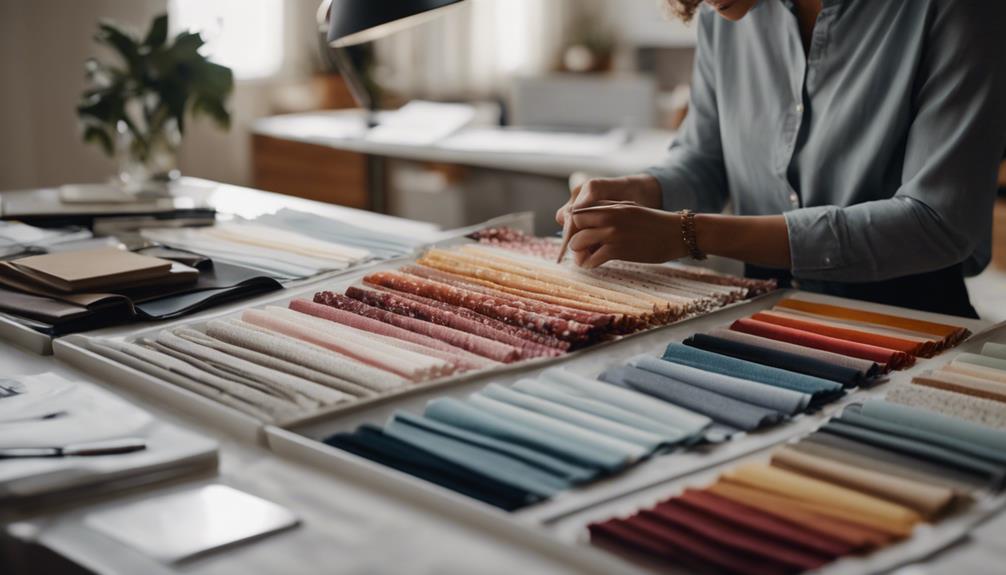
Home decor assistants handle various administrative tasks, including answering phones, scheduling appointments, and organizing paperwork. In addition to these responsibilities, we play an essential role in guaranteeing the smooth operation of interior design projects. Here are some key administrative duties we perform:
- Inventory Management: We assist in maintaining inventory levels, ordering necessary supplies, and tracking shipments to make certain all materials are available for home decor projects.
- Vendor Coordination: We collaborate with vendors and contractors to coordinate deliveries, installations, and other project-related tasks.
- Client Communication: We serve as a point of contact for clients, ensuring effective communication and addressing any inquiries or concerns they may have.
- Creating Mood Boards: We help in the creation of mood boards to visualize design concepts and color schemes for projects.
- Furniture Layouts: We assist in arranging furniture layouts to optimize space and create a cohesive design aesthetic for various spaces.
Contribution to Design Project Execution
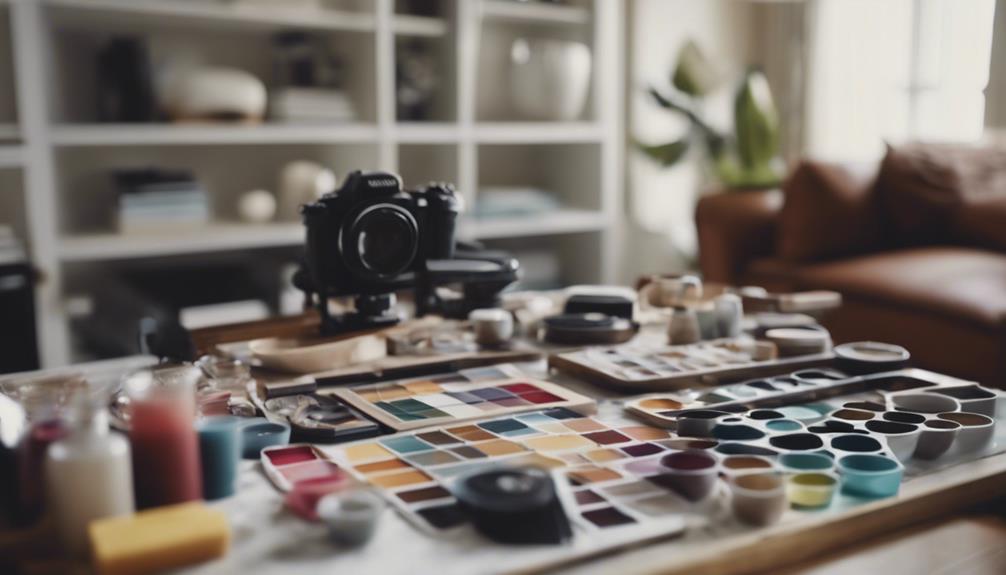
Playing an essential role in the execution of design projects, home decor assistants contribute greatly by sourcing materials, coordinating with vendors, and managing project timelines. As integral members of the team, we assist with tasks such as creating design concepts and selecting decor elements to bring the designer's vision to life.
Additionally, we take on responsibilities like arranging furniture, styling accessories, and organizing samples to guarantee the space reflects the intended aesthetic. Our role extends to collaborating closely with senior designers, clients, and other team members to guarantee the seamless implementation of design plans.
Frequently Asked Questions
What Is the Job Description of a Decorator Assistant?
When it comes to the job description of a decorator assistant, our role involves supporting decorators in tasks like sourcing materials, setting up installations, and assisting with client consultations.
We also manage inventory, coordinate deliveries, and maintain workspace organization. Additionally, we participate in styling photoshoots, showroom set-ups, and stay updated on design trends through trade shows.
Strong communication skills, attention to detail, and a passion for design are key for success in this role.
What Are the Duties of a Design Assistant?
When it comes to the responsibilities of a design assistant, we play a vital role in supporting the design process.
This includes tasks like assisting with creating design concepts, sourcing materials and furniture, coordinating with vendors, organizing samples, and providing administrative support.
Our goal is to guarantee that the design projects run smoothly and efficiently by handling various aspects of the design process.
What Do Home Decorators Do?
As home decorators, we collaborate with clients to curate furniture, accessories, and decor items that suit their style, budget, and preferences. Utilizing design principles and color theory, we transform spaces into functional and visually appealing environments.
Staying updated on industry trends, we provide innovative design solutions. Our services include creating mood boards, coordinating with vendors, and overseeing the implementation of design plans to bring our clients' vision to life.
How Do I Start a Career in Home Decor?
To start a career in home decor, we should first gain an understanding of various styles and trends.
Developing skills in color coordination, furniture arrangement, and creating mood boards is vital. Learning about materials, fabrics, and textures used in decor is essential.
Exploring job opportunities with design firms, stores, or as a freelance decorator can help kickstart our career in home decor. It's important to stay updated on industry trends for success.
Conclusion
In summary, the role of a home decor assistant is essential in ensuring the smooth execution of design projects. From assisting in setting up design spaces to handling administrative tasks, these professionals play a significant role in bringing design visions to life.
Stay tuned for more insights on how home decor assistants contribute to creating beautiful and functional living spaces.
-

 Decorative Throws2 weeks ago
Decorative Throws2 weeks agoIs It Better to Dry Clean Blankets?
-

 Yarn2 weeks ago
Yarn2 weeks agoIs Yarn Natural or Manmade? Unravel the Truth
-
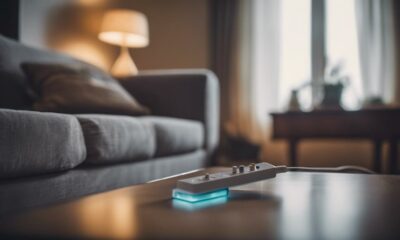
 Decorative Throws2 weeks ago
Decorative Throws2 weeks agoWhat Wattage Is an Electric Throw
-
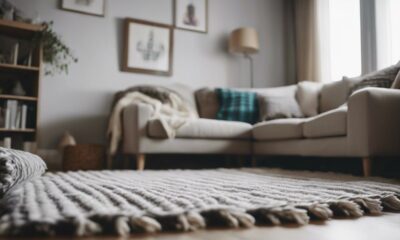
 Decorative Throws2 weeks ago
Decorative Throws2 weeks agoCan I Use a Throw Blanket as a Rug
-
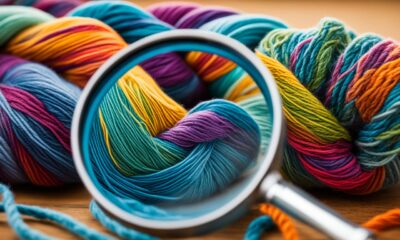
 Yarn2 weeks ago
Yarn2 weeks agoUnravel the Mystery: Why Are Yarn Specs a Secret?
-

 Craft and Textiles2 weeks ago
Craft and Textiles2 weeks ago15 Best Battery-Powered Leaf Blowers for Effortless Yard Work
-

 Tableware and Dining Accessories2 weeks ago
Tableware and Dining Accessories2 weeks agoWhat Is the Meaning of the Word Tableware
-

 Craft and Textiles2 weeks ago
Craft and Textiles2 weeks ago15 Best Toast Recipes to Start Your Day Right















